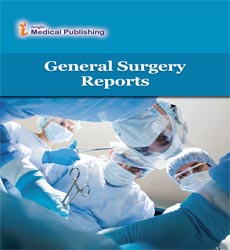Artificial Intelligence of the Surgical Robotics
Cihan Agalar*
Department of General Surgery, University School of Medicine, Turkey
- *Corresponding Author:
- Cihan Agalar Department of General Surgery, University School of Medicine, Turkey, Email: agalar_cihan@gmail.com
Received Date: November 08, 2021; Accepted Date: November 22, 2021; Published Date: November 29, 2021
Citation: Agalar C (2021) Artificial Intelligence of the Surgical Robotics. Gen Surg Rep Vol.5 No.2:e004.
Editorial
Artificial Intelligence (AI), characterized as calculations that empower machines to fill mental roles, (for example, critical thinking and navigation), has changed for quite a while the essence of medical services through AI (ML) and regular language handling.
Its utilization in medical procedure, notwithstanding, took a more drawn out time than in other clinical strengths, essentially in view of missing data in regards to the potential outcomes of computational execution in reasonable medical procedure. Because of quick advancements enlisted, AI is at present seen as an enhancement and not a swap for the expertise of a human specialist. What's more albeit the capability of the specialist patient-PC relationship is quite far from being completely investigated, the utilization of AI in medical procedure is now driving critical changes for specialists and patients the same.
For instance, careful preparation and route have worked on reliably through processed tomography, ultrasound and attractive reverberation imaging (MRI), while negligibly obtrusive medical procedure, joined with automated help, brought about diminished careful injury and worked on quiet recuperation. Preoperative arranging is the stage wherein specialists plan the careful intercession in light of the patient's clinical records and imaging. This stage, which uses general picture examination strategies and conventional AI for arrangement, is being helped by profound realizing, which has been utilized for physical characterization, identification division and picture enrolment.
Profound gaining calculations had the option to distinguish from CT checks anomalies, for example, calvarias crack, intracranial drain and midline shift. Profound learning makes crisis care feasible for these anomalies and addresses a likely key for the future robotization of emergency. Profound learning intermittent neural organizations (RNN) - which have been utilized to anticipate renal disappointment progressively, and mortality and postoperative draining after cardiovascular medical procedure - have acquired superior outcomes contrasted with standard clinical reference devices. These discoveries, accomplished solely through the assortment of clinical information, without manual handling, can work on basic consideration by giving more regard for patients most in danger in fostering these sorts of complexities.
Careful robots can handle the direction, profundity, and speed of their developments with incredible accuracy. They are particularly appropriate for strategies that require something very similar, dull developments as they can work without weariness. Robots can likewise remain totally still however long required and can go where conventional instruments can't. Experience is important in the OR. The more drawn out specialists can continue to do a medical procedure, the better, however surgeries can be actually requesting. The abilities and information that specialists hoard over their professions can be hindered by a deficiency of coordinated movements. Cooperative robots can assist with decreasing the impacts of hand quakes and stay away from accidental or incidental developments.
Inside the activity room, accuracy, convenient help, and the specialist's ability are the way to progress. This is the place where careful robots come right into it. A careful robot is a PC controlled gadget intended to help with the control and situating of careful instruments, empowering the specialist to commit all his thoughtfulness regarding the mind boggling pieces of the medical procedure. Careful robots offer unmatched control as far as speed and development, limiting hand quakes and keeping away from incidental hand developments. This permits the specialist to work with expanded adaptability, accuracy, readiness, and more noteworthy control, particularly during medical procedures that are actually requesting. Man-made brainpower (AI) is a basic component with regards to the advancement of automated a medical procedure. Computer based intelligence based calculations joined with the accuracy and control of careful robots are upsetting the manner in which we see medical procedures in this age. It has the ability to improve on the vehicle of association between careful robots and specialists, with the assistance of profound AI information. For example, it can perceive and decide the developments and examples of a specialist during medical procedure and afterward convert them into significant orders for the robot. Consequently, AI gathers information over the long run by watching specialists perform.
With the assistance of the multitude of gathered information and calculations, AI helps careful robots with thinking and execution of mental capacities like independent direction, critical thinking, discourse acknowledgment, and then some. Simulated intelligence and careful robots likewise assist with breaking down sweeps and medical procedures, identify diseases, and work with instrument situating.
Acknowledgement
None.
Conflicts of Interest
The author declares that there is no conflicts of interest.
Open Access Journals
- Aquaculture & Veterinary Science
- Chemistry & Chemical Sciences
- Clinical Sciences
- Engineering
- General Science
- Genetics & Molecular Biology
- Health Care & Nursing
- Immunology & Microbiology
- Materials Science
- Mathematics & Physics
- Medical Sciences
- Neurology & Psychiatry
- Oncology & Cancer Science
- Pharmaceutical Sciences
